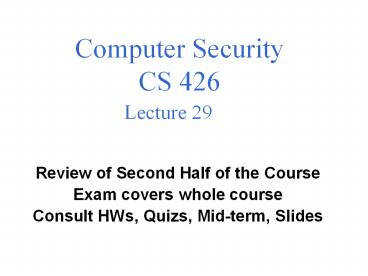Computer Security CS 426 Lecture 29 - PowerPoint PPT Presentation
1 / 12
Title:
Computer Security CS 426 Lecture 29
Description:
Computer Security. CS 426. Lecture 29. Review of Second Half of the Course ... Consult HWs, Quizs, Mid-term, Slides. CS426. Fall 2006/Lecture 29. 2. Cryptography (1) ... – PowerPoint PPT presentation
Number of Views:74
Avg rating:3.0/5.0
Title: Computer Security CS 426 Lecture 29
1
Computer Security CS 426Lecture 29
- Review of Second Half of the Course
- Exam covers whole course
- Consult HWs, Quizs, Mid-term, Slides
2
Cryptography (1)
- Goal of secure communication
- privacy (secrecy, confidentiality)
- authenticity, integrity
- Terminologies
- Steganography, cryptography, plaintexts,
ciphertexts - Adverserial models
- ciphertext-only, known-plaintext,
chosen-plaintext, chosen-ciphertext - Classical ciphers
- shift, substitution (frequency analysis),
Vigenere - One-time Pad, perfect secrecy
3
Cryptography (2)
- Stream ciphers, PRNG, weaknesses (avoid two-time
pad) - Block ciphers (DES, AES, parameters, brute-force
attacks) - Encryption modes ECB, CBC
- Public-key cryptography
- public-key encryption (RSA, how it works, )
- Cryptographic hash function
- three security properties, birthday attack
- well-known algorithms (parameters current
attacks)
4
Cryptography (3)
- Message Authentication Code
- Digital Signature
- Public-key certificates, CA, root CA, trust
- Entity authentication
- password, one-time password, challenge-response
- Key agreement
- Diffie-Hellman
- (Incorrect) Usage web authentication, WEP
- SSL/TLS (What crypto tools are used?)
5
Intrusion Detection Systems
- Classification
- host vs. network,
- signature vs. anomaly-based (pros cons)
- Fase positive/false negative
- Host-based IDS data source, limitation
- Network-based IDS data source, limitation
6
Basic Network Security Problems
- Network packets pass by untrusted hosts
- Eavesdropping, packet sniffing (e.g., ngrep)
- IP addresses are public
- Smurf
- TCP connection requires state
- SYN flooding attack
- TCP state can be easy to guess
- TCP spoofing attack
7
Inherent DNS Vulnerabilities
- Users/hosts typically trust the host-address
mapping provided by DNS - Attacks
- Cache poisoning
- Attacking reverse DNS
8
Firewalls
- Stateless
- Stateful
- Proxy
- Personal
9
Browser Security Issues
- Bugs in browser
- Protecting the browser environment from active
contents (mobile code), e.g., Java applets,
ActiveX controls, Browser helpers, Javascripts - Sandbox
- Signed scripts
- Isolation, same-origin policy
- Privacy issues
- Cookies
- Phishing
10
Common vulnerabilities
- Inadequate validation of user input
- Cross site scripting
- SQL Injection
- HTTP response splitting
- Broken session management
- Can lead to session hijacking and data theft
- Insecure storage
- Sensitive data stored in the clear.
11
Database Access Control
- grant/revoke
- views
- store procedure (invokers right/definers right)
12
Coming Attractions
- December 15
- Final Exam

